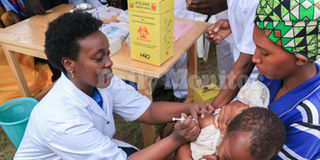What helps pain from immunisation?

A medical worker immunises a child. PHOTO/FILE.
After immunisation, I was advised to cut an onion and put one half where the needle had gone in. What is the importance of using an onion? Sheila
Dear Sheila,
Onions have always been a traditional remedy for a number of disease conditions including a common cold where the onions are cut and placed under one’s feet overnight with socks holding them in place. They are also used to treat feverish convulsions in children where they are inserted in the nose until the subject sneezes and when eaten have been used to treat arthritis and heart conditions in adults.
Although they have traditionally been thought to have anti-inflammatory, antibacterial and antioxidant properties because of Quercetin a flavonoid, onions when used on a vaccination injection site, are unlikely to stop the fever or body pain that accompany a successful vaccination.
Immunisation keeps us safe from a number of infectious diseases but, just like any medication, we may experience side effects after the vaccination. Usually, the side effects are mild and may last a day or two.
The most common side effects are fever, swelling and pain around the area where the needle went into the skin, symptoms that make parents wrongly suspect the vaccine to be fake or to have caused infections.
Whereas these side effects are maligned, when they happen, they show that the vaccine is actually helping form the needed protection against the germ it has been given for.
Formerly, immunisation centres used to give junior aspirin to children being immunised to minimise the side effects but because aspirin causes a dangerous Reyes syndrome side effect, this has been abandoned for low dose paracetamol.
Using a cold mop on the site of the injection can help but if this does not, then panadol can be given. If this fails, then one should consult a doctor.




